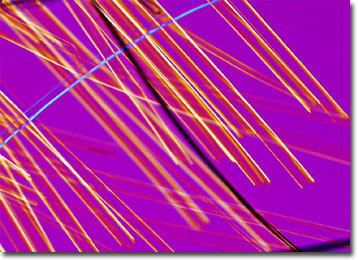Polarized Light Microscopy Digital Image Gallery
Milkweed Fibers
Milkweed is a term used to describe a group of flowering plants belonging to the family Asclepiadaceae. Several varieties of milkweed are cultivated as ornamentals, but some, such as the carrion flower, produce foul odors that attract flies in order to facilitate pollination.

Perennials native primarily to North America, milkweeds are well known for the milky sap that can be found in the leaves, pods, and stems of most species. This sap contains a bitter-tasting alkaloid that discourages most insects and animals from feeding upon the plants, but the larvae of the monarch and other milkweed butterflies have built-in biochemical mechanisms that allow them to consume the substance and store it in their tissues. The stored alkaloid, in turn, makes these butterfly species unpalatable, discouraging potential predators from consuming them.
The fiber of milkweeds, which is often described as floss or silk, is stored in seedpods, which naturally dry and crack open in the autumn, releasing the seeds into the wind for dispersal. Composed of tiny cellulose tubes filled with air, the fibers are unusually buoyant and were utilized during World War II to fill life jackets when kapok fiber became scarce. After the war, milkweed fiber usage tapered off, but over the last twenty years several companies have begun to reexamine the possibilities offered by the soft, lustrous material. Some of these businesses have begun producing comforters and pillows filled with milkweed floss rather than down, while others have explored the materialís ability to recover crude oil from seawater.
